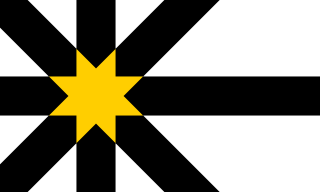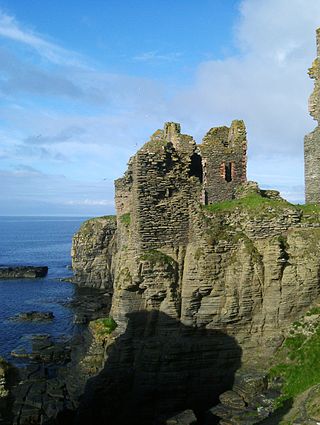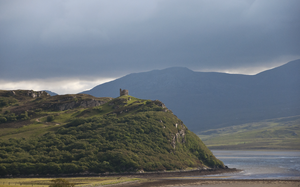
Sutherland is a historic county, registration county and lieutenancy area in the Highlands of Scotland. The name dates from the Viking era when the area was ruled by the Jarl of Orkney; although Sutherland includes some of the northernmost land on the island of Great Britain, it was called Suðrland from the standpoint of Orkney and Caithness.

Tongue is a coastal village in northwest Highland, Scotland, in the western part of the former county of Sutherland. It lies on the east shore above the base of the Kyle of Tongue and north of the mountains Ben Hope and Ben Loyal on the A836. To the north lies the area of Braetongue.

Clan Mackay is an ancient and once-powerful Highland Scottish clan from the far North of the Scottish Highlands, but with roots in the old Kingdom of Moray.

Clan Gunn is a Highland Scottish clan associated with lands in northeastern Scotland, including Caithness, Sutherland and, arguably, the Orkney Isles. Clan Gunn is one of the oldest Scottish Clans, being descended from the Norse Jarls of Orkney and the Pictish Mormaers of Caithness.

Clan Sutherland also known as House of Sutherland is a Highland Scottish clan whose traditional territory is the shire of Sutherland in the far north of Scotland. The chief of the clan was also the powerful Earl of Sutherland; however, in the early 16th century, this title passed through marriage to a younger son of the chief of Clan Gordon. The current chief is Alistair Sutherland, who holds the title Earl of Sutherland.

Clan Sinclair is a Highland Scottish clan which holds the lands of Caithness, the Orkney Islands, and the Lothians. The chiefs of the clan were the Barons of Roslin and later the Earls of Orkney and Earls of Caithness.

Ben Loyal is an isolated mountain of 764 m in Sutherland, the northwestern tip of the Scottish Highlands. It is a Corbett located south of the Kyle of Tongue and offers good views of the Kyle, Loch Loyal to the east, and Ben Hope to the west.

Braal Castle is located by the River Thurso north of the village of Halkirk, in Caithness, northern Scotland. The ruined castle, which dates back to the mid-14th century, was originally known as the Castle of Brathwell.

Castle Sinclair Girnigoe is located about 3 miles north of Wick on the east coast of Caithness, Scotland. It is considered to be one of the earliest seats of Clan Sinclair. It comprises the ruins of two castles: the 15th-century Castle Girnigoe; and the early 17th-century Castle Sinclair. They are designated as a scheduled monument. Lady Amanda Carruthers currently holds the sole title deeds to Castle Sinclair Girnigoe registration no #120439

The Battle of Harpsdale was a Scottish clan battle fought in 1426 at Achardale, about 8 miles (13 km) south of Thurso. The Clan Mackay had invaded Caithness from the west and Harpsdale was where the local Clan Gunn chose to make a stand. Despite great slaughter on both sides, the battle appears to have been inconclusive.

The Battle of Drumnacoub was a Scottish clan battle involving factions of the Clan Mackay fought in the far northwest of Scotland, some time between 1429 and 1433. It took place on a hill called Carn Fada at the southern end of the Kyle of Tongue, between Ben Loyal and the village of Tongue. It was fought between members of the Clan Mackay and men of the Clan Sutherland. The battle was recorded by the 15th century chronicler, Walter Bower, in his work Scotichronicon.

The Battle of Alltan-Beath, also known as the Battle of Ailtan-Beath, was a Scottish clan battle said to have taken place in 1542 in the village of Knockarthur, in Sutherland, in the Scottish Highlands. It was fought between men of the Clan Mackay and men of the Clan Sutherland whose chiefs were the Gordon, Earls of Sutherland.

Borve Castle in Sutherland, Scottish Highlands is now a ruin. Formerly called the House of Burro. It was built in Kirtomy Bay near the hamlet of Farr. It is also known as Farr Castle.

The Kyle of Tongue is a shallow sea loch in northwest Highland, Scotland, in the western part of Sutherland. Featuring a rocky coastline, its mouth is formed at Tongue Bay. The community of Tongue is situated on the Kyle's eastern shore and the loch is crossed by the Kyle of Tongue Bridge and Causeway.
Huistean Du Mackay, 13th of Strathnaver, was the thirteenth chief of Clan Mackay, a Highland Scottish clan.
Angus Du Mackay, 7th of Strathnaver was the seventh chief of the Clan Mackay, a Highland Scottish clan. He is recorded in the 15th-century Scottish chronicle, Scotichronicon, as Enneas-en-Imprissi meaning Angus the Absolute due to his power of commanding 4000 men.

The Battle of Clynetradwell was a Scottish clan battle that took place in 1590 in the county of Sutherland between the forces of Alexander Gordon, 12th Earl of Sutherland and George Sinclair, 5th Earl of Caithness.
The Murrays of Aberscross were a minor noble Scottish family who were seated at Aberscross Castle, in the county of Sutherland, Scotland. The Murrays in Sutherland are recorded specifically as a clan in two acts of the Scottish Parliament of the 16th century.

Ousdale Broch, also known as Ousdale Burn or Allt a’ Bhurg Broch, is an Iron Age broch located between the villages of Helmsdale and Berriedale in Caithness, Scotland.

The Stand-off at Bengrime took place in 1601 and was a stand-off between the armies of John Gordon, 13th Earl of Sutherland and George Sinclair, 5th Earl of Caithness. Bengrime is in the county of Sutherland, Scotland.

















